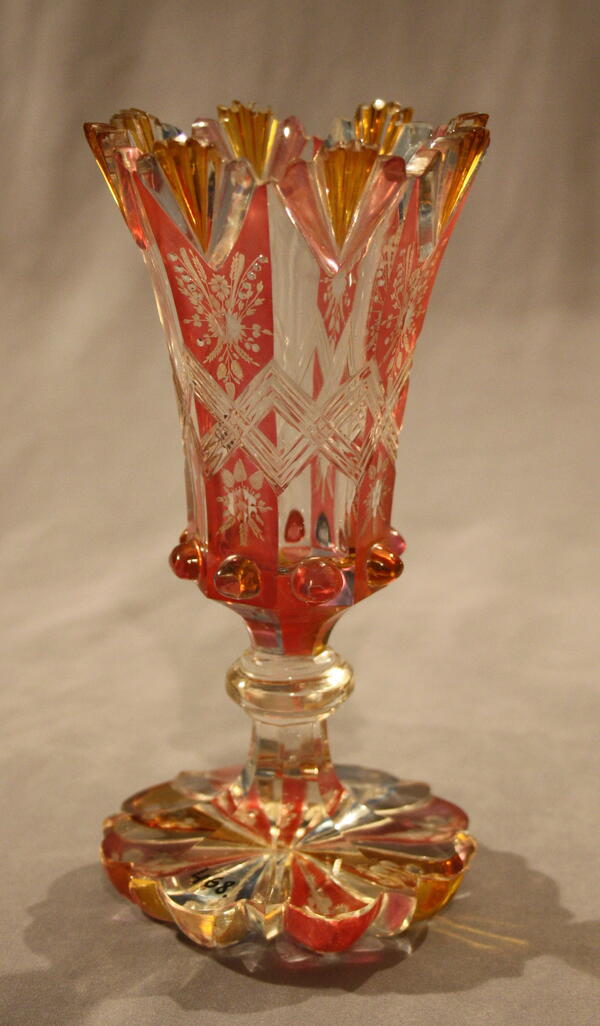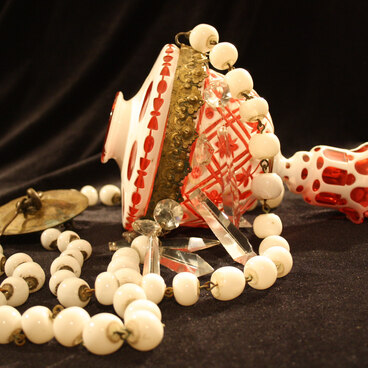This Biedermeier style stemmed glass is made of colorless glass.
Biedermeier is an artistic style that appeared in German and Austrian art, particularly, architecture and design, in the first half of the 19th century. The term originated from a pseudonym, Gottlieb Biedermeier, used by the German poet Ludwig Eichrodt who published epigrams in magazines. The word “bieder” can be translated as “simple, commonplace”, and the pseudonym means “a commonplace Mr. Meier”.
This style was a sort of a mix of Empire and Romanticism that first evolved in architecture and painting and later also developed in such areas as furniture, interior design, and applied art. In the case of applied art, it mostly referred to porcelain and glass products. In all of the areas, Biedermeier is characterized by attention to small details, love for material things, the everyday routine, and the little things in life. It is the art of family values and the lifestyle of an ordinary person.
This colorful and richly decorated stemmed glass from the museum collection demonstrates attention to every detail. The glass was decorated using etching with silver and copper salts and fine engraving. Diffusion coloring with silver salts helps to achieve a yellow color, while copper compounds produce a red color. The method involving copper compounds is a more complicated process that requires three stages of annealing. To use this coloring method, the product’s surface should be carefully prepared, and the special coloring paste should be applied in an even layer.
Such paste contains colorants, as well as chamotte, kaolin, ocher, gum arabic, dextrin, and turpentine. The wildflower bouquets were depicted using the engraving technique: the image was scratched out in the glass using a sharp tool. An image can be engraved using a diamond cutter or a copper wheel. The latter type was traditionally more popular in Russia and was known as “drawing”. Due to the complicated and labor-intensive decoration techniques, such items were among the most expensive ones.
Biedermeier is an artistic style that appeared in German and Austrian art, particularly, architecture and design, in the first half of the 19th century. The term originated from a pseudonym, Gottlieb Biedermeier, used by the German poet Ludwig Eichrodt who published epigrams in magazines. The word “bieder” can be translated as “simple, commonplace”, and the pseudonym means “a commonplace Mr. Meier”.
This style was a sort of a mix of Empire and Romanticism that first evolved in architecture and painting and later also developed in such areas as furniture, interior design, and applied art. In the case of applied art, it mostly referred to porcelain and glass products. In all of the areas, Biedermeier is characterized by attention to small details, love for material things, the everyday routine, and the little things in life. It is the art of family values and the lifestyle of an ordinary person.
This colorful and richly decorated stemmed glass from the museum collection demonstrates attention to every detail. The glass was decorated using etching with silver and copper salts and fine engraving. Diffusion coloring with silver salts helps to achieve a yellow color, while copper compounds produce a red color. The method involving copper compounds is a more complicated process that requires three stages of annealing. To use this coloring method, the product’s surface should be carefully prepared, and the special coloring paste should be applied in an even layer.
Such paste contains colorants, as well as chamotte, kaolin, ocher, gum arabic, dextrin, and turpentine. The wildflower bouquets were depicted using the engraving technique: the image was scratched out in the glass using a sharp tool. An image can be engraved using a diamond cutter or a copper wheel. The latter type was traditionally more popular in Russia and was known as “drawing”. Due to the complicated and labor-intensive decoration techniques, such items were among the most expensive ones.



